Shattered Galaxy Preview
Massively-multiplayer Starcraft it's not, but Shattered Galaxy will be one of the first online strategy games on the market.
It was only a matter of time before a developer took the best qualities of Starcraft and Diablo and combined them with an enormous strategic aspect to create a massively multiplayer strategy game. Nexon's Shattered Galaxy isn't just a strategy game you can play online with seven other players--it is truly a massively multiplayer campaign that could potentially engulf tens of thousands of players. It's a concept that is intriguing and full of promise, and the execution, as we've learned from playing the beta, is actually pretty good.

Nexon is a Korean developer, and it makes sense that from this nation there should come a game that takes the best of strategy and role-playing and goes one step further in the multiplayer arena. The story of Shattered Galaxy is average, but it does an adequate job setting up the action. In the far future, Earth's scientists are experimenting with teleportation. On the verge of a revolutionary breakthrough, these scientists use a lab rat to test out their latest teleportation device. The experiment goes horribly awry, and instead of teleporting the rat to the desired location, the scientists manage to instead teleport a huge chunk of Earth to a far-off galaxy. Deposited in a strange new world, light years from home, those who survived the catastrophic displacement are forced to fight for survival against the aliens of the new world and rival factions that have sprung up from among fellow survivors. What this all means is that you have an excuse to battle to the death against the other factions and strive for galactic dominance.

The setting for Shattered Galaxy is thus a cluster of planets spread out over a few solar systems. Each faction stakes out a claim in a different part of this galaxy, but the beauty of this game is that the geopolitical boundaries are fluid and ever changing. The "world" of Shattered Galaxy is persistent and dynamic, and you and every other player can and will directly contribute to reshaping borders, stealing planets from other factions, and defending your holdings from rapacious enemies. In this game, you and the other players literally control the campaign.
At first glance, Shattered Galaxy looks like a dated game. The graphics are 2D, and the animation is somewhat simple. Then again, this game has to accommodate tens of thousands of players on its servers, with up to 40 players per battle, and all of it over the Internet. So a dated look is understandable. We'll have to wait until the game ships later in the year to find out if it can be forgiven by players at large, though.
The biggest impediment to playing right now isn't the graphics, but the interface. You eventually get used to it, and you can always find a veteran online to clue you in to the workings of the game. However, there isn't a lot of in-game help or control explanations. And many of the terms in the game, such as "influence required," as well as the resources themselves, aren't explained to newcomers. We stumbled through the interface, trying to learn how our various attributes contributed to the units we could buy, equip, and command, and it wasn't clear to us at all how the resources worked. But after asking around and trying out some battles, the game become much easier to manage. Basically, when this game ships, you will need to read the manual, and you'll want to ask other players online for tips and advice. However, once you get past this first stumbling block, you'll find a rewarding and very promising game. Let's take a look.
Chatrooms and Gameplay
Shattered Galaxies is an online-only game, and it supports hundreds and even thousands of players at once. Upon first booting up the game, you are required to choose a faction. There are several factions, occupying various planets, and at first glance, there are no real differences between them. The selection screen displays only the names of the factions and what planet they reside on. The names won't mean anything to you, and there is no other information, history, or description of the factions. Hopefully, in the final version, you will be given some information on the background, leaders, and play style of each faction. Granted, in Shattered Galaxies you are supposed to write the history of the galaxy as you play. And the designers will no doubt assert that they can't commit to faction descriptions when said factions and their territories are dynamically altered by your actions. But still, some sort of flavor text would go a long way to easing a beginning player's concerns that his or her initial decision between factions is just a blind choice.
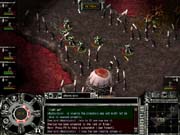
At any rate, as soon as you choose a faction and jump into the game, you are treated to a tutorial that runs you through the basics of the game. However, even here, there is still a paucity of information. There are no lessons on resources, no details on the important attributes of your avatar, and no information on how to upgrade units or purchase equipment. After your tutorial is over, you appear in a sort of faction headquarters area, with various buildings and other members of your faction milling about. As with any other online game, it's the people who make the game. Here, as in other games, there are helpful people and then there are disruptive juveniles. Since we played in a beta environment, most of the people were kind and helpful, but when the game finally ships, all bets will be off.
In the headquarters area, you can take care of all the logistics and prep work for your army. You can buy units, upgrade units, purchase equipment, visit an observatory that shows you the current borders and territories of the various factions, and also enter a few AI-controlled caves where you can skirmish with computer-controlled aliens. As the game is really about fighting other humans, you will earn minimal experience in these AI battles, which are really just meant to show newbies how to fight with minimal risk.
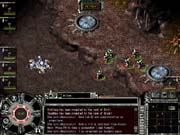
You also can enter the faction HQ building, where you vote for the faction leader. No one in Shattered Galaxies is unaligned. When you enter the game, you join a faction. And the faction leader is responsible for coordinating all the other faction members in the faction's campaign to win territory from the other factions. This faction leader is called an overlord. Aside from having the right to suggest where people fight, the overlord also gives combat bonuses to his troops when he or she actually enters a battle with other faction members. Elections are held fairly often, and supposedly, disgruntled players can even organize coups to appoint new overlords.
Your Avatar
Whenever you aren't in combat in Shattered Galaxy, you're represented by an avatar. Like in an RPG, this character has attributes and gains experience. The four different attributes in the game are tactics, clout, education, and mechanical aptitude.
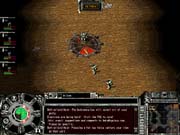
Tactics influences how many units you can control in a battle at a time. Initially, you can control only six units at once. When you enter a battle, that's all you have. Lose those six, and you will have to retreat from the battle and then rejoin with six new units. It is definitely a change from games like Age of Kings and Red Alert 2, where you manipulate hundreds of units. However, as you increase your tactics score, you can add additional units to the maximum you can command. For every 10 tactics points you earn, you can control an additional unit, but you gain only one point to distribute to the tactics attribute for every level advancement, so it will take you at least until level 10 to be able to control seven troops. Clearly, the designers wanted to keep the tactical emphasis on small squads rather than large armies.
Clout influences what level of units you can control. Each unit in the game, of which there are dozens, has an influence-required rating. Your influence rating is based on your experience level and your clout. Thus, all other things being equal, if there are two players of the same level, the player with higher clout will be able to access higher-level troops first. That means he or she will be able to purchase such heavy hitters as far-ranging artillery, cloaking assassins, and other advanced killers.
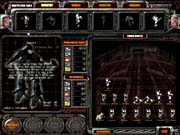
Education influences how quickly you can research new technology at the lab, another building in your headquarters area. Mechanical aptitude determines how soon you can add new equipment to your standard units, as well as how much extra equipment, such as better lasers and engines, you can pack on a single chassis or body.
Although these attributes are crucial to determining your effectiveness in battle, when you first create your character, the creation process does nothing to tell you why any of these four attributes are important. Also, you can adjust these stats when creating your character--decreasing clout to increase your tactics, for example--but since you have no idea what any of these attributes mean, you won't know to do that. This game needs more information during the character-creation phase, and hopefully the final version will provide this information so you can customize your characters from the outset.
Aside from the attributes that define your character, Shattered Galaxy has a lot in common with RPGs like Diablo. You can advance in level in four categories: infantry, mobile, aviation, and organics. These categories are the different types of units. As you advance in level in each category, you gain an attribute point to spend. You don't have to advance evenly, and if you choose, you could be level five in aviation and level one in everything else. In that case, you've decided to specialize in air combat units. To advance, you need experience, which is gained every time your units themselves advance in level. Your units in turn gain experience by fighting in battles and killing units. Basically, if you take care of your troops, they take care of you. And as you advance in level and spend your attribute points, more options become available to you, in the form of new units, new technologies, upgrades, and more slots to add to your squad.
Battle Experience
The actual business of battle occurs when you decide to hop through the gates in your headquarters area to different territories on the various planets. When you select a territory, the ranking commander on the field (the player with the highest tactics) decides whether to let you in or not. Once in, you'll battle with your allies against the enemy faction. Because your squad is so small, most players in the beta seemed to concentrate on one type of unit. For instance, in one battle we fought, there was an air specialist with six aircraft, a heavy mobile specialist with six behemoths (large tanks), and an infantry specialist who had six ground troopers. We came in with three infantry, a robot, a bomber, and a scout fighter, and we quickly discovered that we couldn't really contribute because we were spread too thin. Unlike the other players, we didn't have a specialty, and thus we weren't as useful as the others. We promptly retreated and came back in with a force of five fighter planes and a redeye, a robot that can scan the battlefield for enemy units. We had found our niche.
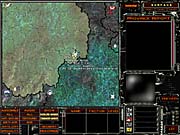
In battle, you win by controlling points of control, a concept that should be familiar to most wargamers. Each map has one to four points of control, and you win the battle if you can hold them all for at least 30 seconds. However, the enemy will be trying to do the same, so you'll engage in lots of skirmishes with enemy units. With such small squads, though, you'll have to be careful and intelligent in battle; you don't have the luxury of churning out units and throwing them at the enemy. What you bring in is all you have. There is also no resource gathering at all--just searching and destroying. However, there are interesting elements on all battlefields. Your units will eventually run out of ammo, so there are one or two nodes scattered on the map that will slowly regenerate ammo if you park your unit over them. There are also small clusters of resources, like uranium or ore. Some of your infantry have what is basically backpack space. When they walk over the small clutch of minerals, their inventory bar will fill. If you get out alive, you'll come through with a few extra resources. Of course, these minerals are just a small-time payoff. You don't actually get the majority of your wealth this way. Instead, you earn cash periodically from tribute. If you have been fighting lots of battles for your faction, you'll get a good chunk of cash. But if you've been dawdling and just chatting with other characters in the HQ, you'll get little to no cash.
Shattered Galaxy isn't your typical strategy game, and it's definitely a departure from what gamers are playing now. It combines the character development of Diablo with smaller-scale real-time strategy gameplay. And even the smaller-scale combat, centering on less than a dozen units under your command, is only a single aspect of this much larger game. There is technology research and lots of buying and upgrading out of combat in what amounts to a leisurely and glorified chat room. Ultimately, what will make or break this game is the gameplay and the combination of character advancement, scaling of better and better units, and the quick real-time battles. The game should ship very soon, so we'll all have the opportunity to test the viability of a new galactic conflict where players drive the campaign.
Got a news tip or want to contact us directly? Email news@gamespot.com
Join the conversation